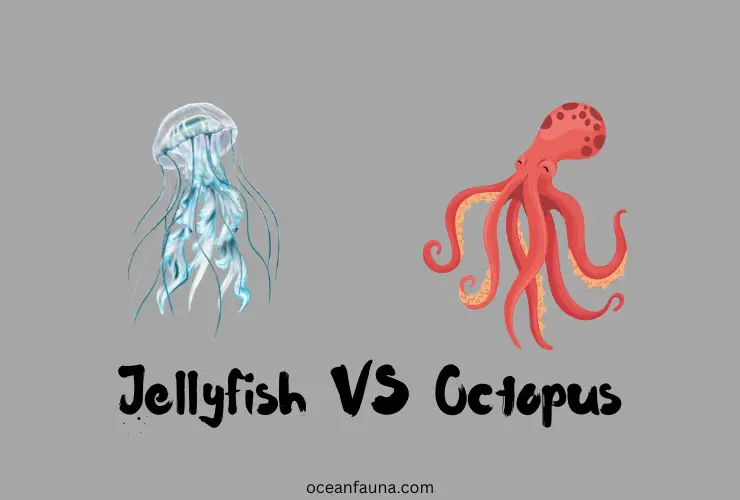Jellyfish and octopuses are the two living invertebrates in marine life. These animals seem almost the same, but they are very different. Surprisingly, you would wonder when the facts will reveal. So, what are the key differences between jellyfish vs octopuses?
Jellyfish have a shorter lifespan than octopuses. Jellyfish have no heart, brain or eyes. On the other hand, all of these organs are present in octopuses. Jellyfish use nematocysts, whereas octopuses use their beaks to attack prey. Jellyfish can produce light, and octopuses can’t.
There are more differences between these popular sea creatures. Here, I will cover all the facts and differences. So, stay tuned.
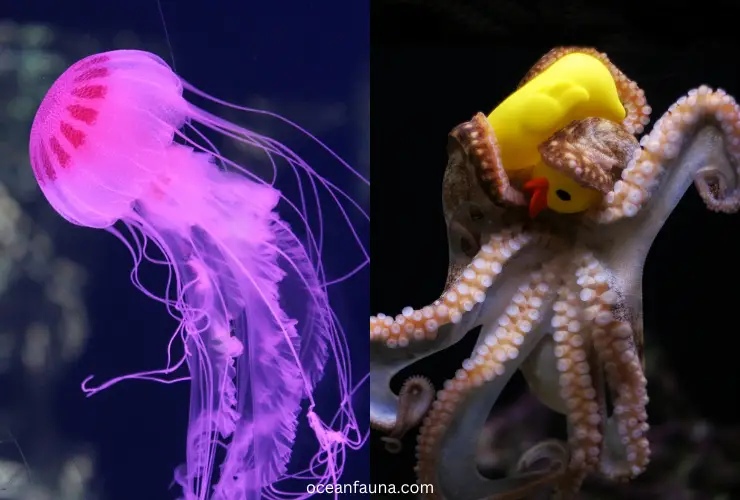
Jellyfish Vs Octopus: Quick Comparison Chart Table
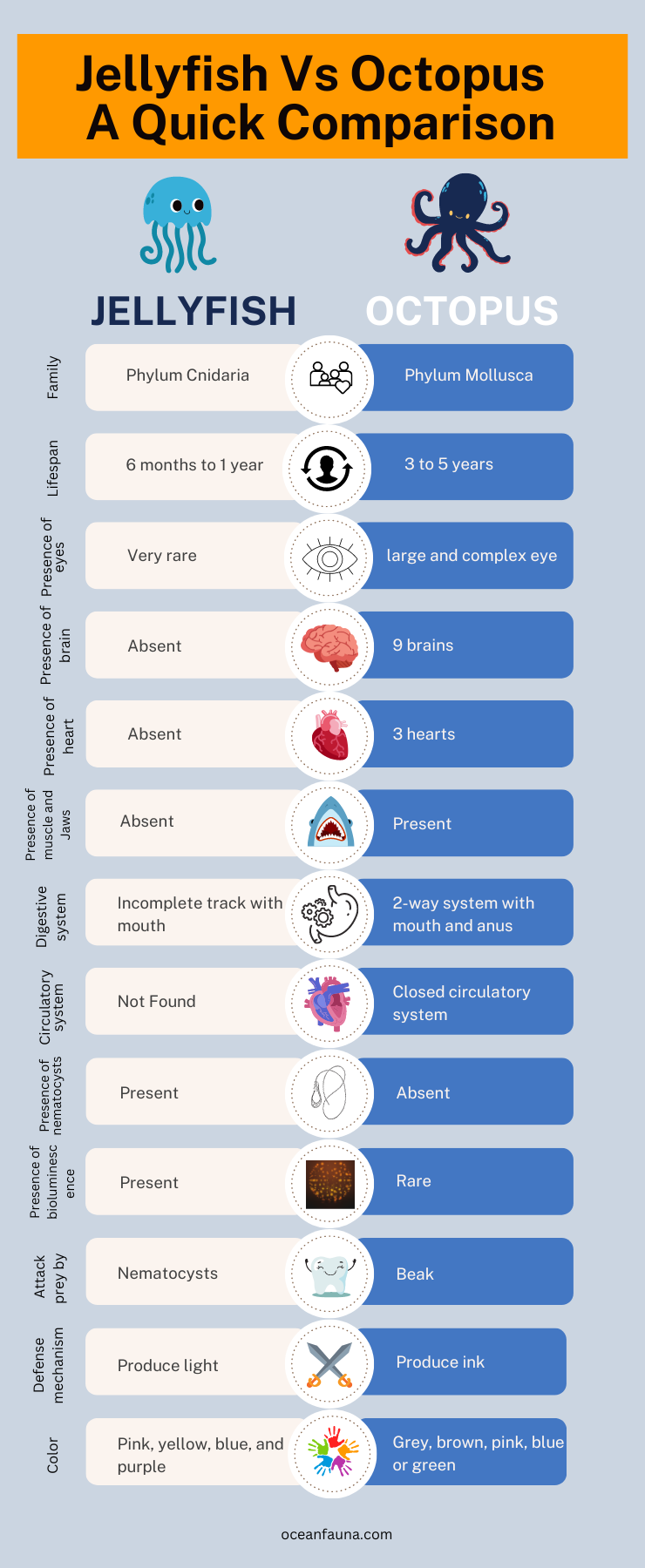
Jellyfish Vs Octopus: Key differences
Let’s find out more exciting things about jellyfish and Octopus with a detailed comparison.
Family
Both Jellyfish and Octopuses are sea creatures. But, they belong to different Phyla. The anatomy and physiology of these two creatures are very different from one another.
For this reason, Jellyfish belong to Phylum Cnidaria. Octopuses belong to Phylum Mollusca.
Lifespan
The jellyfish has a shorter lifespan than an octopus. The average lifespan of an octopus is 3 to 5 years. Whereas, The maximum lifespan of a jellyfish is between 6 months to 1 year.
In the case of octopuses, different species can live much longer or have a short lifespan.
Like, the Giant Pacific octopus has the longest 3-5 years lifespan. Again, the Atlantic pygmy octopus has a short lifespan of 4-8 months.
Similarly, Lion Jellyfish have the longest lifespan, up to 1 year. Again, Cannonball jellyfish only has a short lifespan of 3-6 months.
Presence of eyes
Octopuses have two eyes like humans on their skin. The eyes are very large and complex. The diameter of each one is between 15-20 mm.
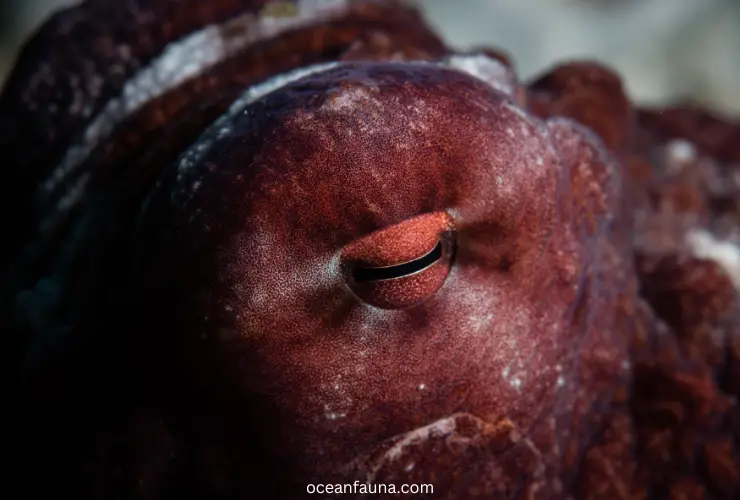
Octopuses can see what’s surrounding them and even humans also. They have to use their eyes to find food, shelter and hunt.
Usually, jellyfish have no eyes, but that doesn’t mean they are fully blind. Their sensing organs of light, also known as rhopalia act as eyes.
Surprisingly, box jellyfish have acquired a total of 24 eyes. Their eyes are on their bells.
Presence of brain
Octopus have 9 brains which is the reason behind their sharp and intelligent activity! On the other hand, jellyfish have no brains at all.
Octopuses have 8 mini-brains on their 8 tentacles. These mini-brains help the arm to act perfectly with speed and sharp reflexes.
The 9th brain mainly works on the entire nervous system and helps the other eight brains operate tentacles.
Jellyfish have no brain, so how do they survive without a brain? Instead of having brains, they have a set of nerves. This is also known as the “nervous system”. These nerve senses help jellyfish to sense touch, temperature, and salinity.
Presence of heart
Octopuses have 3 hearts, whereas jellyfish don’t have a single heart.
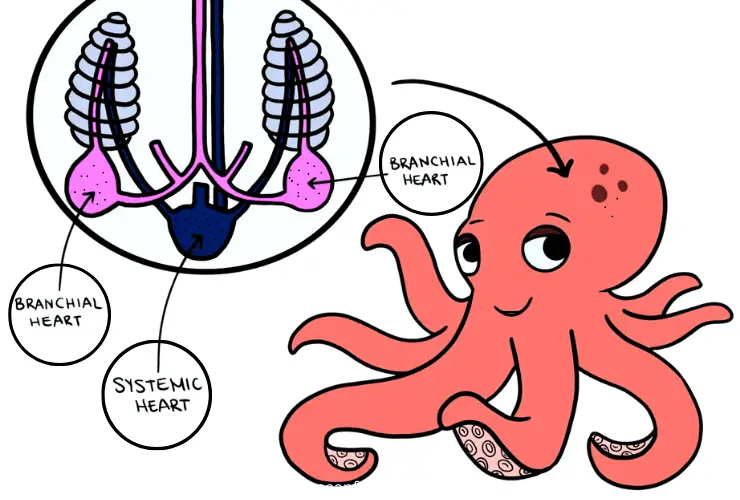
Between the 3 hearts, two hearts of the octopus act as the branchial hearts. The function of these hearts is mainly to pump blood through the gill.
The other central heart acts as a systematic heart- circulates blood to the entire body, organs, and muscles. The blood of the octopus is blue for the presence of hemocyanin(copper-rich protein).
Jellyfish don’t need any heart as they don’t have blood. Simply, it doesn’t need to pump blood. Again, they can also absorb oxygen with their thin skin
Digestive system
Octopuses have a two-way digestive system which is a complex but complete system. In contrast, jellyfish have an incomplete digestive system which is simpler than an octopus.
Usually, octopuses hunt lobsters, crabs or shrimp to eat. Once eating is complete, it is digestive in their stomach. Then, digestive glands shift through the food. After that, nutrients transfer throughout the blood on the body and are released to the anus.
Instead of lacking the liver, pancreas or intestines, a large cavity helps jellyfish to digest food in the jellyfish stomach. The cavity functions as cells to produce everything to digest the food in the bells.
After eating completely, undigested waste is out of the mouth. So, here the incomplete digestive tract carries with the mouth.
Presence of nematocysts
There’s a significant difference between jellyfish and octopuses with the presence of nematocysts. Jellyfish have nematocysts to protect them and attack prey. In comparison, octopuses have no nematocysts but have beaks.
There are thousands of nematocysts cells in each tentacle. To attack or catch prey, nematocyst helps jellyfish to inject toxins into the body of prey and hence the prey gets paralyzed.
Octopuses have no nematocysts but have beaks to attack prey. The beak of an octopus is considered a weapon that is really sharp and hard. Octopuses use it to break, rip and tear the body of prey.
Presence of bioluminescence
Have you ever seen the magical glow in the dark sea? If you have, you may wonder how it is possible. The answer is bioluminescence.
Bioluminescence is the chemical process that allows some sea creature bodies to produce light. Jellyfish are bioluminescent that use light to defend against predators.
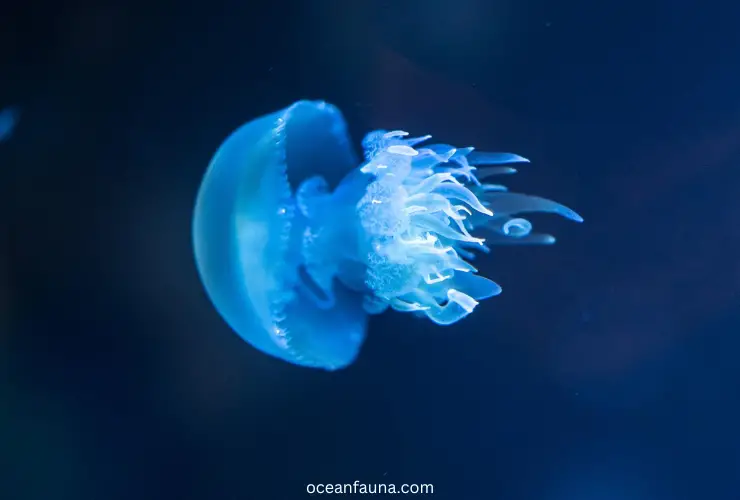
There’s a very rare octopus that is bioluminescent. Like Bolitaena pygmaea, a female octopus produces light to attract mates.
Defense mechanism
The jellyfish and octopus have their tricks to defend against any predators and here they make a difference.
Jellyfish defend themselves by distracting predators. Here, they produce light as they are bioluminescent.
Well, octopuses aren’t bioluminescent. However, they defend themselves by producing ink and distracting predators.
Color
Octopus and jellyfish have various colors. Most octopuses have pink, blue, yellow, and purple colors. Octopuses can also change their body colors in a few seconds.
On the other hand, jellyfish color can be changed due to their diet. They can be gray, brown, pink, blue or green colors.
Conclusion
Jellyfish and octopuses are the most common sea creatures with few similarities and many dissimilarities. For this reason, they are categorized into different phyla and families.
Hope you’ve enjoyed a lot to know the significant differences between them. Give us your feedback and opinion about this article. Is this helpful or not?
It’s time to say goodbye. Will be met on another interesting topic.

